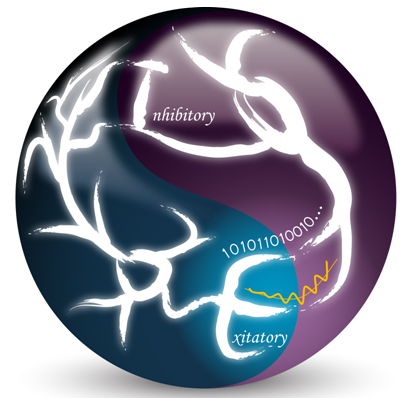Time:2011-03-23
On March 22, PLoS Biology published a study entitled "Membrane Potential-Dependent Modulation of Recurrent Inhibition in Rat Neocortex". This work was carried out by Jie Zhu, Man Jiang, Mingpo Yang and Han Hou, under the supervision of Dr. Yousheng Shu.
The two major opposing forces in your cerebral cortex, excitatory pyramidal cells and inhibitory interneurons, are always fighting with their weapons, spikes. It has been widely believed that firing those stereotyped pulses at each other is the only way for the two classes of neurons to strike a balance and keep your brain cool. Recently, Dr. Yousheng Shu’s research group at the Institute of Neuroscience discovered a new strategy that the cortex use to maintain the balance of excitation and inhibition, by showing that the amount of inhibition depends on the membrane potentials (Vm) level of pyramidal cells.
The cerebral cortex consists of recurrent neuronal networks, where pyramidal cells send action potentials (i.e. spikes) down along their axons to excite interneurons, which in turn inhibit pyramid cells through the so-called disynaptic inhibitory postsynaptic potentials (IPSPs). This back-and-forth process serves to keep the excitation/inhibition ratio stable, and thereby maintain proper functioning of the cerebral cortex. In the classical view, action potentials are delivered if and only if the Vm exceeds a certain threshold and if action potentials are invariable in their shape, an all-or-none fashion of rapid neuron-to-neuron communication which characterizes the brain as a “digital computer”. Nevertheless, one might ask whether there exists any other form of communication, say, analog signaling, that also participates in maintaining the balance of recurrent networks. The answer has proven to be yes.
Using paired recording from two pyramidal cells within a recurrent circuit, Jie Zhu and collaborators discovered that a slight positive shift (depolarization) in Vm of the first pyramidal cell could considerably increase, or even sometimes turn on, the disynaptic IPSPs received by the second cell. Further experiments, using paired recording from pyramidal cells and inhibitory interneurons together with pharmacological manipulations, suggested the following model: the subthreshold depolarization in presynaptic pyramid cells inactivates a special type of potassium current, the D current, and stretches the width of axonal action potentials, enhances excitatory synaptic transmission to the interneurons, elevates their firing of spikes, and finally facilitates disynaptic inhibition.
This study provides the first evidence demonstrating that an analog change in excitation can regulate subsequent feedback inhibition, with the information carriers no longer being stereotyped. This type of regulation could be a key mechanism for the cortex to maintain a dynamic balance of excitation and inhibition, and generate appropriate cortical rhythms under different behavioral states. It may also play an important role in preventing abnormal cortical activities including epileptiform activity during seizures.
Future studies focusing on whether Vm-dependent modulation of inhibition has a great impact on information processing under physiological and pathological conditions, and whether the analog signaling influences the operation of other cortical circuits would be of great interest. Last but not least, to what extent these findings might shake the conceptual framework of the “digital brain” is open to computational and theoretical studies.
This work was supported by the 973 Program (2011CBA00400 and 2006CB806600), the National Natural Science Foundation of China Project (31025012), the Shanghai Pujiang Program 07PJ14108, the Knowledge Innovation Project from Chinese Academy of Sciences (KSCX2-YW-R-102).

In a Chinese Taiji depiction, two complementary forces of cortical networks, excitatory (lower) and inhibitory (upper) neurons, strike a balance through a hybrid of digital ("10101...") and analog (orange waveform) communication. (Illustration by Han Hou)
 附件下载:
附件下载: